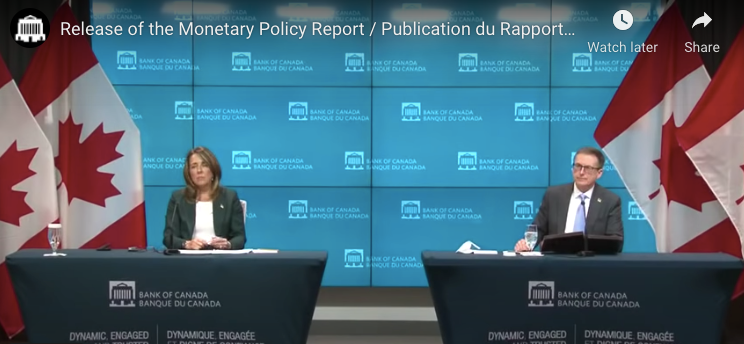Future Of Interest Rates (Part 2):


Last week I sent you Part 1 of the Bank of Canada’s (BoC) official press release after announcing a 0.50% policy rate hike. Their press release is an executive summary of the April Monetary Policy Report.
Part 2 (below) is an analysis from the question and answer period. Select members of the press ask questions of the governor and senior deputy governor of the Bank of Canada. Let’s review these questions, and more importantly, the answers …
Note: the Q&A period is about 30 minutes of content. I am not covering every question and answer. I am covering what I think are the most important questions relating to inflation, interest rates and housing.


Part 2: Question & Answer Breakdown:
Press Question #1:
In the past the BoC was not worried about inflation being unanchored to the 2% target. That is not the case anymore?
Tiff Macklem Answer #1:
The longer inflation remains above target greater is the risk Canadians think higher inflation is going to persist. This becomes imbedded in their inflation expectations. The need to make sure inflation expectations remain moored to the 2% inflation target was reflected in our decision today.
Much of the higher inflation we are experiencing today is from international forecast. War in Ukraine pushed inflation higher by disrupting supply chains and pushing oil higher which is the principal reason our inflation forecast revised higher.
As supply chains re-open, the price of oil lowers, inflation in Canada will come down given that inflation expectations remain anchored to the 2% target.
The other part is with our economic momentum, and excess demand. Our domestic inflationary pressures are also increasing.
The other reason for raising today, and signaling further increases is we need to bring demand and supply back to balance and bring inflation back to target.
Chad Commentary #1:
Clearly the BoC is committed to bringing down inflation given the fact they raised rates by 0.50% last week. Their forward guidance is also quite clear – more rate hikes are coming to bring inflation down.
In my previous email, I outlined the A-B-C’s of how rate hikes bring inflation down. The BoC is trying to tame excess demand in the wake of pandemic re-opening. This will work, but to what extent and cost? A major contributing factor for today’s inflation is supply side issues.
If the BoC stomps out excess demand via higher rates enough to balance the current supply restriction, that might be harmful to other areas of Canada’s economy I.E., housing.
I’ve been writing you for years about the unfortunate reality of stagflation. This is where we have high inflation, with anemic GDP growth. This makes continual rate hikes a difficult decision. I guess this is where business investment is expected to help Canada’s economy!!
Press Question #2:
Markets have been anticipating a 3% neutral rate in the next year, which is higher than the neutral rate of the previous rate hike cycle. Considering household indebtedness, how prepared are Canadian households and what are you looking for?
Tiff Macklem Answer #2:
In terms of the neutral rate, that was lowered due to the pandemic. As we anticipated risk of labour scaring, much weaker investment, and lower potential output growth. What’s happened since then is the economy has bounced back very strongly. We now have a labor market that has more than recovered from the pandemic. Our concerns for labour scarring are reduced, and strong investment intentions from our businesses which means more potential output. Reflecting that we have moved our rage for the neutral rate back up to 2-3%.
In the opening statement reference to the policy rate closer to neutral, and from there we probably need to be more humble. If demand responds quickly to higher rates, and there are clear signs of moderation in inflation, it may be appropriate to pause once we are closer to neutral at least for a period.
But equally, we might have more work to do. The economy has considerable momentum, labor markets are tight and if that momentum continues we may need to take rates modestly above neutral for a period to restore balance between demand and supply to bring inflation back to target.
We will be watching closely to how the economy responds to higher rates. And we are aware that household indebtedness is high in this country and that could mean the effect of rates will be more pronounced. On the other hand, households have actually saved more through the pandemic. Their household balance sheets have improved and that will tend to work in the other direction. So we will be watching closely to how the economy responds to higher rates. And the most important thing we will be watching is the evolution for an outlook on inflation. We are committed to bring inflation back to target and we are prepared to be forceful if needed.
Chad’s Commentary #2:
Let’s all acknowledge this …the financial exit ramp from the pandemic is about as uncertain as the financial onramp into the pandemic.
The governor of the Bank of Canada clearly explained two very plausible paths for this rate hike cycle.
One, rates rise and households whether the storm. We all adjust leaning on strong balance sheets and business investment growing. Totally plausible.
Two, cracks in the economy appear with higher rates. The rate hike trajectory (rhetoric) slows, or even reduces, thus finding a neutral interest rate lower than originally thought. I think this is totally possible too.
I think some combination of both paths plays out. I think the BoC is going to over tighten rates to combat generationally high inflation. This will lower domestic related inflationary pressures, but not solve global supply side issues. The great hope is global supply chains open to assist in balancing with demand. Once inflation expectations are more closely anchored to the top end of the inflation range (3%), I think we’ll see rate cuts seeking a lower neutral interest rate.
Press Question #3:
Real Estate’s been a big driver of growth, yet you anticipate housing to be a drag on growth but expect other parts of the economy to pick up the slack? How did you come to the conclusion that housing will slow and are you confident that exports and business investment will pick up the slack when your predecessor was serially disappointed?
Senior deputy governor Carolyn Rogers Answer #3:
Housing activity will moderate over time as interest rates go up. We should remember it is also starting from a extremely elevated level, so even as it moderates we think it will stay high. We don’t think this will have a big drag on the economy. We spoke about the risk that elevated house prices bring along elevated debt levels and that bring vulnerability – especially in an increasing rate environment. So we are watching this carefully.
We see a number of economic offsets. 1) Balance sheets have improved, people paid down debt, and increased savings. That will give them a buffer against rising rates. We should remember rates are coming from all-time lows. 2) Macro-prudential policies have been in place for years now. Borrowers for Mortgages are stress tested so they have some distance to go before from where rates are to the stress test highs. This will buffer households from higher rates too.
In terms of business investment …not exactly an offset to the housing market but we are hearing from businesses that there is a strong intention to invest as the economy recovers from the pandemic, and health restrictions come off.
Chad’s Commentary #3:
Ok, fair enough re: household balance sheets and stress testing borrowers.
I have a couple counter thoughts tho …1) as the economy opens up I think spending/travel are returning which is contributing to domestic inflationary pressure. Over a long enough period of time household balance sheets are likely to return to long-term averages. Can those balance sheets withstand higher rates? 2) I can’t help but think of all the folks across Canada that deferred their Mortgages at the first sign of loss of income. How healthy are these balance sheets really? 3) My beard is 100% more grey waiting for “business investment” to help prop up our economy. Former governor of the BoC continually referred to business investment coming.
With all the kicking and screaming my industry did at the implementation of the B-20 Mortgage guidelines (stress test), I am very glad – as a Canadian – those qualifying rules are in place now.
Conclusion:
I covered three questions, answers and provided my humble commentary from the Bank of Canada press conference after they announced a 0.50% rate hike.
Overall, our National economy can go one of many directions. I’m committed to continuing to watch, review and communicate what is happening in our Mortgage market.
Thinking locally …I think Calgary is a great place to live, work and invest in Real Estate (personal residence). I think we have a great deal of long term Real Estate tail winds to feel confident about.
If you like or appreciate this content, please let me know. Any other Mortgage or Real Estate related question/need – let me know!
Talk soon,
Chad Moore
P.S.
Hey! Thanks for reading …what you think will happening with interest rates? I’m out here trying to make sense of all this and I’d love to hear from you!
Recent Posts
Calgary Market Update—March 2025 Data
Here are some Calgary Real Estate numbers, across all property types, out of the gate for…
Interest Rates Up Or Down?
Hey Guys! Tariffs are here. Now what? Tiff Macklem, governor of the Bank of Canada, gave…
Bank of Canada Hot Mic Moment
Hey Guys! The Bank of Canada publishes "meeting deliberation notes" relating to the discussion of raising,…
Banker’s Damaging Admission
When the governor of the Bank of Canada speaks, we listen! Tiff Macklem, governor at…
January 2025 Market Stats
Let's look back at January 2025 Calgary Real Estate Board (CREB) data to make sense…
Mortgage Interest Rate Review
Hey Guys! Here's an example of how the Bank of Canada is in a balance…


